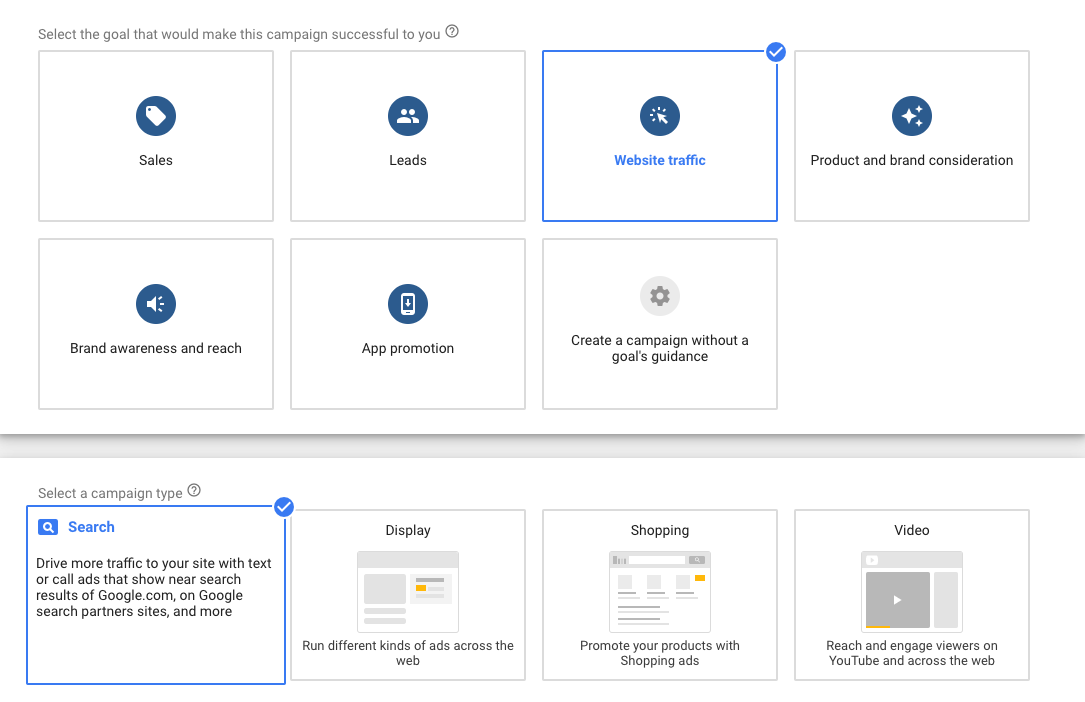As a marketer, it’s no doubt that you know how important Google Ads can be for promotion and marketing of your services or products. However, creating a Google Ads strategy that utilizes your budget effectively and gives you the highest return on investment (ROI) can be difficult.
After all, how can you actually maximize your budget and see results that increase sales and engagement over time? Fortunately, there are many ways to take your current strategy and make it stronger. From the campaign type you choose and the keywords you target to the measuring your success, simple adjustments are all that is needed to take your current Google Ads strategy, flip it around, and see a much better pay-per-click (PPC) average in no time.
Begin by Using the “Search Campaign Type”
There are many campaign types to choose from, but the two most commonly used ones are search network and display network.

While many people opt for display network because of the engagement they receive, the actual click-through rate (CTR) for this campaign type is typically fairly low. The reason for this is that display network campaigns focus on getting your name out there, while search network campaigns are more about actual conversions.
Imagine display network campaigns as that one friend of yours that goes on five dates a week. Sure, they have a multitude of dates but the second or third dates with a particular person never happen. In this way, your friend is attracting lots of people but never seeing actual conversions from the initial attractions.
With display networks, your ad is posted on a collection of sites, including Google sites with no warm lead-in to be seen. Although more people will see this ad, the people that are seeing it are not guaranteed to be interested in it and, therefore, are less likely to click less. This lowers your overall conversion rate for that campaign exponentially. By contrast, search network campaigns display your ads on websites that are search-related, meaning the initial interest in the topic is there.
If your marketing goal is to increase awareness, then display network campaigns might be the right choice for you. But if you’d like to increase conversions and (hopefully) sales, you can really maximize your Google Ads budget by beginning with the “search network only” campaign type.
Related: Google Adwords for Newbies: 5 Easy Tips
Use the “Search Lost Budget” Column
Just as you should measure your success with Google Ads, you should also measure your losses. This is one of the most common things business owners forget when first using Google Ads. If you can’t determine where you can improve or where to focus your budget, you could easily find yourself losing large quantities of your Ads budget to keywords that aren’t even producing.
With this said, a great way to maximize your Ads budget is to use the “search lost impression” column, which will show you how many times your ad did not show up on the search network because of a low budget. This is a good way to see how much you should, in fact, be putting towards particular keywords and how a lower budget on some keywords is leading to major losses in the long run.
Measure Your ROI and PPC Frequently
There are many ways to measure success in Google Ads, but the most efficient way to do so is to measure your Pay-Per-Click (PPC) and your Return on Investment (ROI). According to Wordstream, “In the US, if you average across all different types of businesses and keywords, the average PPC in Google Ads is between $1 and $2. That’s on the search network. On the display network, clicks tend to be cheaper, and the average is under $1.”
With this said, as you measure your PPC on various keywords, you will want to analyze whether putting more money towards them is ideal or not. If a PPC is higher than these averages, this means that the keyword is not performing as well as it should and, perhaps, a more well-performing keyword should acquire its budget.
When it comes to ROI, this goes beyond the amount you pay for a click and into the realm of whether or not there are clear conversions occurring from certain keywords over others. For instance, if your keyword is getting a lot of clicks but you are not receiving any leads from it, you may want to consider the reason for this. Most likely, there is a disconnect between the message in your ad and the message on the landing page. Make sure you are collecting the right data from your website visitors and targeting the right demographics with your content.
A good way to measure your ROI is to use this formula: ROI= Profits / Cost. If your profits don’t exceed your cost, then it’s time to consider a different campaign strategy.
By measuring these two elements of Google Ads, you can determine what keywords you should focus on and how successful this form of advertising is for your business.
Related: How to Rank on the First Page of Google
Don’t Overbid on Keywords That Have a Low ROI
All too often, companies overbid on keywords simply to spend their entire Ads budget. This is a “quantity over quality” situation where business owners believe that spreading their budget to countless keywords is the best way to spend the money they have.
Unfortunately, this is not the case. The truth is that keywords with a low ROI should not have money continuously sent their way. However, because a large amount of the average business owner’s Google Ads campaign is automated, these owners continuously put money towards ineffective keywords, effectively throwing a large portion of their budgets away each month.
This is where doing true keyword research and Google Ads campaign research comes into play. When starting off with a campaign, you should first determine the keywords you want to target. Decide how valuable they are and what times during the day they are most searched or frequented. Another key decision factor that comes into play is having buyer personas; knowing who you are targeting will also help you determine the most popular keywords for that demographic.
Monitor which keywords perform best over time and update your allocated budget accordingly. Just remember that while you may be tempted to put a lot of dollars behind a successful keyword, you should never overbid on one keyword or your ROI will suffer.
Utilize Shared Budgets to Find Which Keywords Perform Best
Shared budgets are basically the “colosseum of keywords.” By using a shared budget for multiple keywords, you give these keywords the same budget and watch as they compete for the largest amount of that budget. This is great for business owners who are either new to Google Ads or are unsure of how successful a list of keywords will be.
Once the campaign is over, you can easily determine which keywords have done best and which do not deserve a part of the budget for next month. In doing this, you can narrow down your campaign keywords and hone in on a select few that perform best in less time.
Related: 6 Must-Use Tools to Master Google Analytics
Schedule Your Ads Within Your Hours of Operation
Imagine someone see your ad at six in the evening, they want to call you, and they receive no response. This is a surefire way to lose initial interest you may receive through your advertisements. To avoid this, try scheduling your ads within your hours of operation to always be available in the case of someone wanting more information.
This is also a good decision for higher-performing campaigns so you do not overspend each month. If you’re at the office while the ads are running, you can watch them more closely to avoid going over your budget.
Now that you know the best tips for maximizing your Google Ads budget, it’s time to start implementing them into your own campaigns and reaping the benefits of a more structured and effective Google Ads strategy. After all, your business deserves the attention—you just have to determine the most cost-effective way to get it.
But if this all still seems like a lot to take in, consider reaching out to the digital marketing experts at Ironmark. We can help you define your business’ marketing goals and create a Google Ads campaign to reach them. Contact us today to get started!




